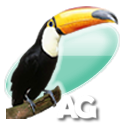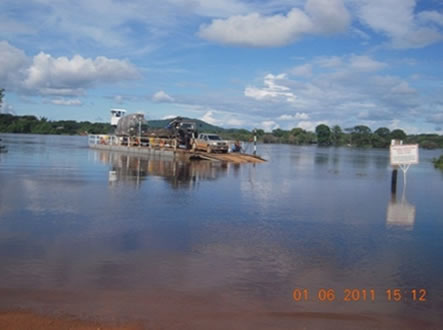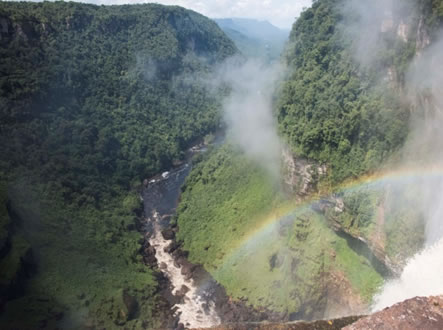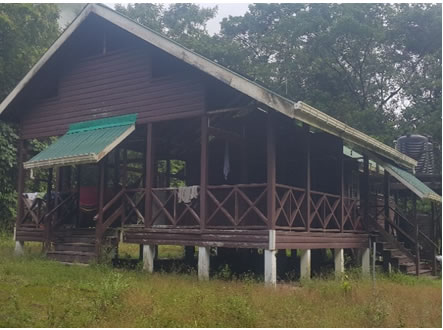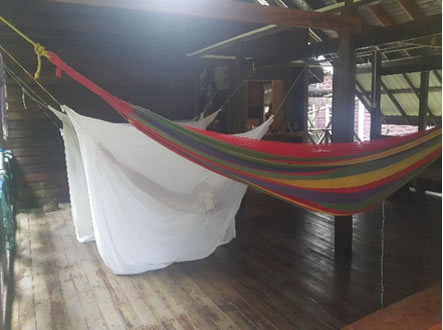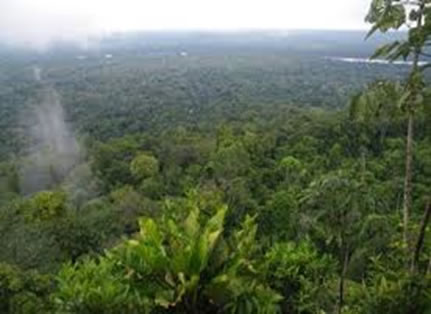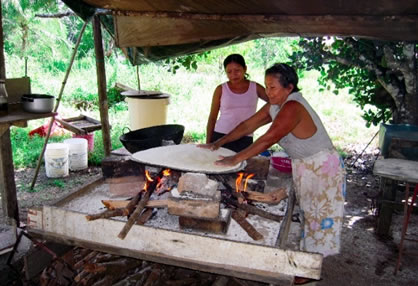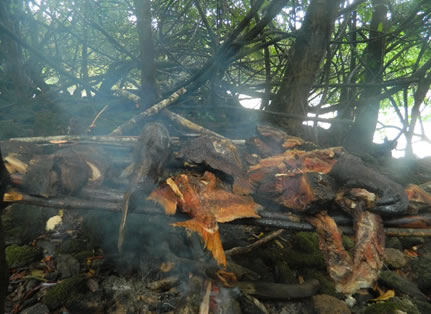Wild Guyana-Giants of El Dorado
$4890 per person
“Guyana, South America Undiscovered, is known for its pristine rainforests, vast savannahs and wetlands, and is considered one of the most unfrequented area of the Amazon Region. Wild Guyana takes you to the remote corners of this nature paradise in search of South America’s Giants, namely the Giant River Otter, Black Caiman, Harpy Eagle, Giant Anteater, Arapaima, Capybara, Giant River Turtle, Anaconda and South & Central America’s largest cat- the elusive Jaguar. This itinerary is also ideal for photographers, both amateur and professional.
Download and print -:- Wild Guyana-Giants of El Dorado Itinerary.
Minimum Group Size -:- 2 Persons.
Included:
-
- Arrival and departure transfers
- Domestic flights
- All accommodation
- Services of English speaking guides – please note that you will have a different guide in each place on the itinerary, rather than the same guide throughout the trip
- Meals as listed (B – Breakfast, L – Lunch, D – Dinner)
- Entrance fees for sites listed as part of the itinerary
Excluded:
-
- International flights
- Any airport taxes
- Travel Insurance
- Visas
- Drinks
Day 1: Arrival
Airport transfer to Georgetown: Experience Guyana’s Historic Landmarks, Colonial Architecture dating back to the Seventeenth Century, and its pluralistic, ethnically, racially and religiously diverse peoples, referred to as the “Melting Pot” of the Caribbean. The City tour is mostly by foot and takes between two to three hours: Overnight SleepInn Hotel or Equivalent
Day 2: Kaieteur Falls
 Today take a flight across Guyana’s pristine rainforest into the Pakaraima Mountains to the famous Kaieteur Falls, the world’s highest free-falling waterfall, where the Potaro River drops 741 feet into the gorge below. Tour the various view -points at your own leisure with a private guide and in the afternoon, witness thousands of swifts making their way back to their habitat behind the falls. Return to Georgetown: Overnight SleepInn Hotel or Equivalent
*On occasion the visit to Kaieteur Falls may need to be re- scheduled.
Today take a flight across Guyana’s pristine rainforest into the Pakaraima Mountains to the famous Kaieteur Falls, the world’s highest free-falling waterfall, where the Potaro River drops 741 feet into the gorge below. Tour the various view -points at your own leisure with a private guide and in the afternoon, witness thousands of swifts making their way back to their habitat behind the falls. Return to Georgetown: Overnight SleepInn Hotel or Equivalent
*On occasion the visit to Kaieteur Falls may need to be re- scheduled.
Kaieteur Falls: Kaieteur Falls is a spectacular site, five times higher than Niagara Falls, and one of the most powerful waterfalls in the world. First seen by Europeans in 1870 it was known to indigenous people before this – the legend is that it was named after a great chief. Although there are taller and wider falls, Kaiteur’s distinction comes from its combination of both volume of water and height. . Here we hope to find White-chinned and White-tipped Swifts swirling over the gorge, and the astonishingly colorful Guianan Cock-of-the-Rock
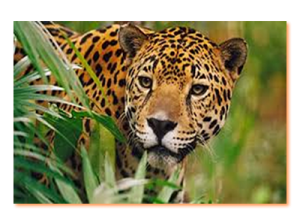
Day 3: Georgetown to Iwokrama River Lodge
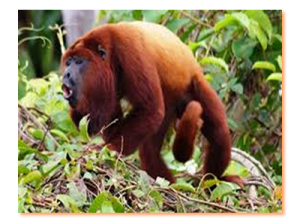 Take mid- morning flight to the Iwokrama Rainforest Reserve. The Iwokrama Rainforest is a vast wilderness of one million acres. This protected area was established in 1996 as the Iwokrama International Centre for Rainforest Conservation and Development. Iwokrama is exceptional among conservation organizations because it joins with local people in every aspect of its work. From research to business, Iwokrama ensures local economic and social benefits from forest use and conservation. The Forest is in the homeland of the Makushi people, who have lived here and used the forest for thousands of years. This afternoon, we would explore the trails around the river lodge with an Iwokrama Ranger. Iwokrama is home to many bird species and the elusive Jaguar. The Iwokrama forest is rapidly gaining an international reputation for its healthy jaguar populations that seem not to be troubled by the appearance of curious humans. This evening we take a drive along the dirt road linking Guyana and Brazil to some of the areas where previous sightings of Jaguars have occurred. No promises, but many have been lucky. Return to the Lodge for Dinner: Overnight Iwokrama River Lodge (LD)
Take mid- morning flight to the Iwokrama Rainforest Reserve. The Iwokrama Rainforest is a vast wilderness of one million acres. This protected area was established in 1996 as the Iwokrama International Centre for Rainforest Conservation and Development. Iwokrama is exceptional among conservation organizations because it joins with local people in every aspect of its work. From research to business, Iwokrama ensures local economic and social benefits from forest use and conservation. The Forest is in the homeland of the Makushi people, who have lived here and used the forest for thousands of years. This afternoon, we would explore the trails around the river lodge with an Iwokrama Ranger. Iwokrama is home to many bird species and the elusive Jaguar. The Iwokrama forest is rapidly gaining an international reputation for its healthy jaguar populations that seem not to be troubled by the appearance of curious humans. This evening we take a drive along the dirt road linking Guyana and Brazil to some of the areas where previous sightings of Jaguars have occurred. No promises, but many have been lucky. Return to the Lodge for Dinner: Overnight Iwokrama River Lodge (LD)
Day 4: Turtle Mt Hike & Piraiba Lodge
 After breakfast, you will leave the river lodge for the journey to Turtle Mountain, and an exhilarating climb up the mountain to its summit at 935ft (approx. 360m). It takes 1 3/4hrs to walk up the mountain, but the effort is more than worth it for the breathtaking views over the forest canopy when you get there and chances of Green Aracari, White Bellbird or a fly-by of one of five types of Eagles. This trail is also a great location for seeing Black Spider Monkey and Red Howler Monkey and if we are very lucky even a Jaguar. This pristine forest offers huge buttress trees and the endemic Greenheart, a highly sought after hardwood. Return to the River Lodge for lunch and continue by boat deep into the jungles of Guyana. The boat ride ends at Adventure Guianas Piraiba (Lau Lau) Lodge, which is situated on the Eastern Bank of the Essequibo River, deep into the Jungles of Guyana. This four-bedroom facility offer guests a mixture of comfort and rusticity, surrounded by pristine rainforest, full of wildlife. This evening we would do a bit of fishing whilst observing the several species of macaws, toucans etc returning to their habitats to sleep. After dark, we’ll set out on the river, in hopes of finding the Black Caiman or another of its four species, and listen for night birds such as Spectacled Owl, White-winged Potoo, Rufous Potoo, Long-tailed Potoo, Zigzag Heron or Blackish Night Jar and one or another of the four species of caiman -Overnight Piraiba Lodge (BLD)
After breakfast, you will leave the river lodge for the journey to Turtle Mountain, and an exhilarating climb up the mountain to its summit at 935ft (approx. 360m). It takes 1 3/4hrs to walk up the mountain, but the effort is more than worth it for the breathtaking views over the forest canopy when you get there and chances of Green Aracari, White Bellbird or a fly-by of one of five types of Eagles. This trail is also a great location for seeing Black Spider Monkey and Red Howler Monkey and if we are very lucky even a Jaguar. This pristine forest offers huge buttress trees and the endemic Greenheart, a highly sought after hardwood. Return to the River Lodge for lunch and continue by boat deep into the jungles of Guyana. The boat ride ends at Adventure Guianas Piraiba (Lau Lau) Lodge, which is situated on the Eastern Bank of the Essequibo River, deep into the Jungles of Guyana. This four-bedroom facility offer guests a mixture of comfort and rusticity, surrounded by pristine rainforest, full of wildlife. This evening we would do a bit of fishing whilst observing the several species of macaws, toucans etc returning to their habitats to sleep. After dark, we’ll set out on the river, in hopes of finding the Black Caiman or another of its four species, and listen for night birds such as Spectacled Owl, White-winged Potoo, Rufous Potoo, Long-tailed Potoo, Zigzag Heron or Blackish Night Jar and one or another of the four species of caiman -Overnight Piraiba Lodge (BLD)
Day 5: Piraiba Lodge to Apoteri & Rewa Amerindian Village
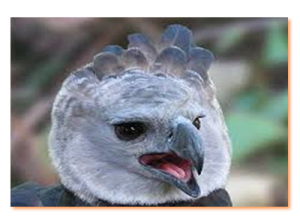 This morning we would set out on a boat ride further up the mighty Essequibo River, amidst lots of birdlife, hoping to see the Capybara, Giant Otter, Tapir, Primates (common are the Red Howler, Spider, Capuchins & Squirrel Monkeys) and even the elusive Jaguar, maybe feasting on a Giant River Turtle or Arapaima or just swimming from one bank to the other. The journey concludes at Apoteri, located on the confluence of the Rupununi and Essequibo Rivers. The name Apoteri c omes from the Arawaks name of a tree. The history and development of Apoteri village is closely tied to the balata industry. In the 1970 Apoteri was formed as a base for the business firm, Booker Brothers, McConnell & Company, popularly known as Bookers. Workers from all over the region came to work there mainly from villages in the south Rupununi like Shea, Sand Creek, Sawariwau and Krowdar. Today the village has several tribes including Patamona, Wapashina and Makushi. After lunch continue to Rewa Amerindian Village. The Village of mostly Macuchi and Wapishana Indians, is located on the confluence of the Rewa and Rupununi Rivers. The river tour offers an ideal opportunity to see the Giant Otters, Caimans, Capybaras and myriad bird species. In 2005/2006 the Village constructed the first set of Benabs, overlooking the Rewa and Rupununi Rivers, and established a sustainable eco-tourism business, self-owned and operated. Today, accommodation has improved with additional Lodges, despite being relatively unknown and unfrequented. This afternoon, our Guide will take you on a Village Tour, where traditional customs are practices are very much alive. Experience cassava grating, farine (local staple) making, weaving etc: Overnight Rewa Eco Lodge (BLD)
This morning we would set out on a boat ride further up the mighty Essequibo River, amidst lots of birdlife, hoping to see the Capybara, Giant Otter, Tapir, Primates (common are the Red Howler, Spider, Capuchins & Squirrel Monkeys) and even the elusive Jaguar, maybe feasting on a Giant River Turtle or Arapaima or just swimming from one bank to the other. The journey concludes at Apoteri, located on the confluence of the Rupununi and Essequibo Rivers. The name Apoteri c omes from the Arawaks name of a tree. The history and development of Apoteri village is closely tied to the balata industry. In the 1970 Apoteri was formed as a base for the business firm, Booker Brothers, McConnell & Company, popularly known as Bookers. Workers from all over the region came to work there mainly from villages in the south Rupununi like Shea, Sand Creek, Sawariwau and Krowdar. Today the village has several tribes including Patamona, Wapashina and Makushi. After lunch continue to Rewa Amerindian Village. The Village of mostly Macuchi and Wapishana Indians, is located on the confluence of the Rewa and Rupununi Rivers. The river tour offers an ideal opportunity to see the Giant Otters, Caimans, Capybaras and myriad bird species. In 2005/2006 the Village constructed the first set of Benabs, overlooking the Rewa and Rupununi Rivers, and established a sustainable eco-tourism business, self-owned and operated. Today, accommodation has improved with additional Lodges, despite being relatively unknown and unfrequented. This afternoon, our Guide will take you on a Village Tour, where traditional customs are practices are very much alive. Experience cassava grating, farine (local staple) making, weaving etc: Overnight Rewa Eco Lodge (BLD)
Day 6: Rewa Eco Lodge
 After breakfast, head out to the Rupununi River for a gradual hike, except for a few steep areas, up the Awarmie Mountain. Along the trail, there is chance to see a few specie of primates, lots of birds, no less than the Harpy Eagle. The summit presents a good opportunity to view the nearby Mountain Ranges, and possibly, sighting of the Red Howler Monkeys, that you would have heard along the way. Return to the Lodge for lunch. After lunch travel up the Rewa River to “Sea Wall” which is named after a rock formation and is ideal for fishing (maybe some peacock bass for dinner). Here is also home to the largest scaled fresh-water fish, the Arapaima. Return to the Lodge before dark, and be sure to keep an eye out for River Turtles, Caimans, Capybaras that frequent this water shed. Overnight Rewa Eco Lodge (BLD)
After breakfast, head out to the Rupununi River for a gradual hike, except for a few steep areas, up the Awarmie Mountain. Along the trail, there is chance to see a few specie of primates, lots of birds, no less than the Harpy Eagle. The summit presents a good opportunity to view the nearby Mountain Ranges, and possibly, sighting of the Red Howler Monkeys, that you would have heard along the way. Return to the Lodge for lunch. After lunch travel up the Rewa River to “Sea Wall” which is named after a rock formation and is ideal for fishing (maybe some peacock bass for dinner). Here is also home to the largest scaled fresh-water fish, the Arapaima. Return to the Lodge before dark, and be sure to keep an eye out for River Turtles, Caimans, Capybaras that frequent this water shed. Overnight Rewa Eco Lodge (BLD)
Day 7: Outdoor Camp
 After breakfast depart Rewa Eco lodge for a trip along the river for wildlife spotting. Late afternoon watch or join in as your guides construct a camp on the river bank. Enjoy a dinner cooked over an open fire before spending the night in your hammock camp. (BLD)
After breakfast depart Rewa Eco lodge for a trip along the river for wildlife spotting. Late afternoon watch or join in as your guides construct a camp on the river bank. Enjoy a dinner cooked over an open fire before spending the night in your hammock camp. (BLD)
Day 8: Karanambu Lodge
 Awaken to the dawn chorus of Howler Monkeys and break camp and continue on the Rupununi River to Karanambu Lodge. Depending on the river level, this trip offers an excellent opportunity to look for Giant Otters as there are several family groups which live along this stretch of the Rupununi River. The journey ends at Karanambu Lodge, the home of late Diane McTurk, widely known for her work in rehabilitating orphaned, giant river otters. Diane and her otters have appeared on National Geographic, Jeff Corwin Experience, Really Wild Show (BBC) and the Calgary’s “Zoo World”. Karanambu has a long history of visiting naturalists and Diane’s father, Tiny McTurk, has welcomed David Attenborough and Gerald Durrell (Three Singles to Adventure). Late in the afternoon we will travel by boat to look for wild Giant River Otters and as dusk falls to the ponds to see the giant Victoria Regis waterlily, bloom at dusk. On the return trip we will spotlight for Black Caiman and birds and creatures of the night. Overnight at Karanambu Lodge (BLD)
Awaken to the dawn chorus of Howler Monkeys and break camp and continue on the Rupununi River to Karanambu Lodge. Depending on the river level, this trip offers an excellent opportunity to look for Giant Otters as there are several family groups which live along this stretch of the Rupununi River. The journey ends at Karanambu Lodge, the home of late Diane McTurk, widely known for her work in rehabilitating orphaned, giant river otters. Diane and her otters have appeared on National Geographic, Jeff Corwin Experience, Really Wild Show (BBC) and the Calgary’s “Zoo World”. Karanambu has a long history of visiting naturalists and Diane’s father, Tiny McTurk, has welcomed David Attenborough and Gerald Durrell (Three Singles to Adventure). Late in the afternoon we will travel by boat to look for wild Giant River Otters and as dusk falls to the ponds to see the giant Victoria Regis waterlily, bloom at dusk. On the return trip we will spotlight for Black Caiman and birds and creatures of the night. Overnight at Karanambu Lodge (BLD)
Day 9: Karanambu to Caiman House
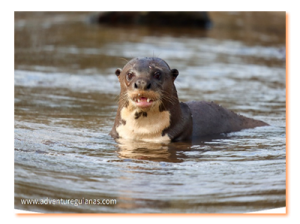 This morning we go out into the Savannahs in search of Giant Anteaters, which has been very successful over the years. Return to the Lodge for breakfast and continue by boat along the Rupununi River, birdwatching along the way, to the Amerindian village of Yupukari and Caiman House. Tonight enjoy a foray on the Rupununi River from Caiman House Field Station. As a guest you have the unique opportunity to support and participate in an ongoing field study of the Black Caiman, the largest member of the Alligator family, and an endangered species. If the water level is low enough you will be invited to accompany the indigenous crew as they search for and capture these magnificent reptiles on the river. Overnight at Caiman House. (BLD)
This morning we go out into the Savannahs in search of Giant Anteaters, which has been very successful over the years. Return to the Lodge for breakfast and continue by boat along the Rupununi River, birdwatching along the way, to the Amerindian village of Yupukari and Caiman House. Tonight enjoy a foray on the Rupununi River from Caiman House Field Station. As a guest you have the unique opportunity to support and participate in an ongoing field study of the Black Caiman, the largest member of the Alligator family, and an endangered species. If the water level is low enough you will be invited to accompany the indigenous crew as they search for and capture these magnificent reptiles on the river. Overnight at Caiman House. (BLD)
Caiman House: Caiman House is the hub of several participatory development projects, including the introduction of classroom libraries in all three village schools and an internet-enabled public library. Visitors may have the opportunity to meet local craftspeople, including the furniture builders at Yupukari Crafters, a non-profit venture to create village jobs and generate income to sustain educational development. Tonight enjoy a foray on the Rupununi River from Caiman House Field Station. As a guest you have the unique opportunity to support and participate in an ongoing field study of the Black Caiman (melanosuchus niger), the largest member of the alligator family and an endangered species. Guests will observe the capture from a separate boat, but will be offered the opportunity to assist in data collection. Caiman are weighed, measured, sexed and tagged before being released back into the river. The research has already discovered interesting information on caimans’ nests that was previously unknown. During periods of high water it is difficult to capture Caiman so you will have another chance to enter the nocturnal world of the Rupununi River and associated gallery forests which offer an experience, and world of wildlife entirely different than those viewed on a day trip.
Day 10: Caiman House
 Today we will travel by boat from Awariku Lake following the creek through the forest, before emerging into the Rupunini River and drifting downstream- this provides good opportunities for spotting a variety of birds including the elusive Agami Heron and the Rufescent Tiger Heron. We will spend time this morning observing village life before returning to Caiman House. This afternoon we will head out on to the Rupununi River, where we will select the perfect sandbank to set up camp for dinner under the stars- this is a good opportunity to try your hand at local fishing. Sip your drinks as the sun sets while the crew prepare dinner. On the way back to the lodge you will see many birds settled for the night in the branches of the trees, such as Capped Herons, Black Crowned Herons, Boat Billed Herons, and Nightjars. Along the banks you can look for black and spectacled caiman and on occasions Capybara who come down to drink at the river. Overnight at Caiman House. (BLD)
Today we will travel by boat from Awariku Lake following the creek through the forest, before emerging into the Rupunini River and drifting downstream- this provides good opportunities for spotting a variety of birds including the elusive Agami Heron and the Rufescent Tiger Heron. We will spend time this morning observing village life before returning to Caiman House. This afternoon we will head out on to the Rupununi River, where we will select the perfect sandbank to set up camp for dinner under the stars- this is a good opportunity to try your hand at local fishing. Sip your drinks as the sun sets while the crew prepare dinner. On the way back to the lodge you will see many birds settled for the night in the branches of the trees, such as Capped Herons, Black Crowned Herons, Boat Billed Herons, and Nightjars. Along the banks you can look for black and spectacled caiman and on occasions Capybara who come down to drink at the river. Overnight at Caiman House. (BLD)
Day 11: Lethem (Guyana & Brazil Frontier) to Georgetown
 After breakfast, we set off to the Village by vehicle to the Guyana/Brazil Border Township of Lethem, located in the Upper Takutu-Upper Essequibo Region of Guyana. Lethem is considered the capital of Region 9 and is a hub linking many of the surrounding Indigenous Villages with Georgetown and Boa Vista, the nearest town in Brazil. The recently commissioned Takutu River Bridge links the two countries and offers greater opportunities for trade and commerce. The town is approximately 280 feet above sea level and has a mixed population of approximately 3,500, with a heavy influence of Brazilian Culture. It is named after Sir Gordon James Lethem, who was the Governor of British Guiana from 1941 to 12 April 1947. After an exhilarating two weeks, take a one hour flight to EF Correia Airport, where our vehicle will take you to Georgetown: Overnight Sleepinn International or Similar (B)
After breakfast, we set off to the Village by vehicle to the Guyana/Brazil Border Township of Lethem, located in the Upper Takutu-Upper Essequibo Region of Guyana. Lethem is considered the capital of Region 9 and is a hub linking many of the surrounding Indigenous Villages with Georgetown and Boa Vista, the nearest town in Brazil. The recently commissioned Takutu River Bridge links the two countries and offers greater opportunities for trade and commerce. The town is approximately 280 feet above sea level and has a mixed population of approximately 3,500, with a heavy influence of Brazilian Culture. It is named after Sir Gordon James Lethem, who was the Governor of British Guiana from 1941 to 12 April 1947. After an exhilarating two weeks, take a one hour flight to EF Correia Airport, where our vehicle will take you to Georgetown: Overnight Sleepinn International or Similar (B)
Day 12: Onward Travels
Standard Check List; All may not be applicable
-
- Broad rim or peaked sun hat.
- Lightweight, quick dry, light colored long pants and shirts (to minimize mosquito bites at night and sunburn in the day)
- Lightweight socks that dry quickly.
- Shorts, bathing suit, T-shirts (ideally light color cotton)
- Slippers or sandals (for easy on and off around camp, or when boots drying out)
- Appropriate boots for hiking.
- Poncho
- Sunscreen and chap stick
- Insect repellent
- Medications for specific personal conditions (for allergic reactions, heart conditions, digestive disturbances, malaria prevention etc.)
- Calamine lotion or sunburn cream
- Sunglasses (ideally with carrying straps)
- Small personal first aid kit (aspirins, small bandages, rubbing alcohol,antibiotic cream, diarrhea medication, gauze pads and rolls of tape insect cream)
- Plastic water bottle
- Backpack
- Personal toiletries (toothbrush, paste, soap, small towel, etc.)
- Small flashlight and extra batteries (indispensable if you have to get out of the hammock at night)
- Camera, lenses, films, memory card
- Copy Biographic page of Passport
- Requisite Visas (Check with Respective Embassies).
- Yellow Fever Vaccination Card
